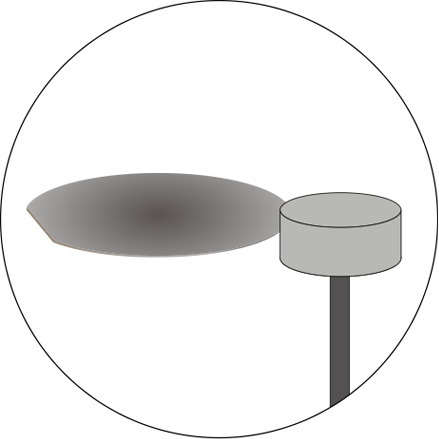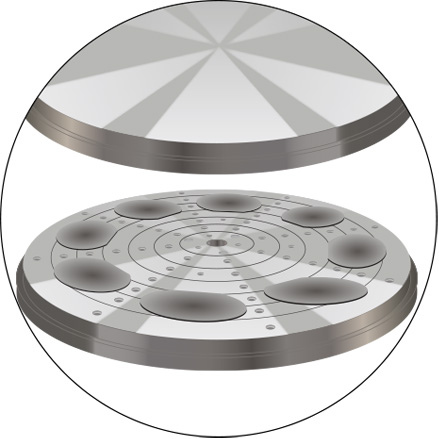
937-859-8503

937-859-8503
 Roto-Grind
Roto-Grind
For precision rotary grinding hard and rigid materials, the Roto-Grind 1012HD from Roto Tech has remained the industry leader for grinding challenging substrates like silicon, ceramic components and quartz. Performing ultra high precision rotary grinding requires a grinding machine that is ultra rigid and stable. The Roto-Grind 1012HD is engineered specifically for the most challenging and exacting specifications on the most difficult materials, including advanced ceramics.
Call Today for a Demonstration or Send Us a Note...
By weight, the most common element in the Earth's crust after oxygen is silicon. Galactically speaking, it's believed to be the seventh most common element in the universe. Like oxygen, it's everywhere. Silicon is in the soil, the air and the water. Silicon can also be found in plants, tissue, bones and body fluids.
But also like oxygen, silicon is difficult to pinpoint in nature. Classified as a metalloid, silicon is too reactive to be found by itself and must be extracted from the element with which it has reacted. Once separated, pure silicon is very rigid with a metallic appearance and a crystalline structure similar to diamonds.
Silicon is just as prevalent in modern industry. Taking advantage of silicon’s reactive properties, it is combined with many other elements to produce a wide range of materials, from engine blocks, transformer plates and machine tools to hair conditioners, cosmetics and sealants.
Performing ultra high precision rotary grinding requires a rotary grinding table that is ultra rigid and stable to allow for the use of the exotic and specialized grinding wheels for grinding hard materials like silicon.
The Roto-Grind 1012HD is engineered specifically for the most challenging and exacting specifications on the most difficult materials, including advanced ceramics. That's why ceramic manufacturers and machine shops ask for Roto-Grind Precision Rotary Grinding Tables. Roto-Grind Rotary Grinding Tables are still built in the USA and maintains the same rugged and rigid craftsmanship as the first Roto-Grind in 1958.
Roto-Grind Precision Rotary Grinding Tables were originally engineered to tackle ultra hard materials. Even as manufacturing and processes have become more advanced, technical and extreme, Roto-Grind has consistently delivered solid results.
|
An etching process clears the relatively rougher areas of the wafer surface. |
Another outside diameter rotary grind is applied to smooth the edges from the wafer slicing |
The silicon wafer is inspected to determine if specification flatness and thickness has been achieved. |
|
An etching process clears the relatively rougher areas of the wafer surface. |
|
Another outside diameter rotary grind is applied to smooth the edges from the wafer slicing. |
|
The silicon wafer is inspected to determine if specification flatness and thickness has been achieved.
|
Silicon Wafer Grinding
Perhaps silicon’s most relevant contribution is to electronics. Replacing the electron tube, silicon-based transistors required significantly less power, were significantly smaller, generated much less heat and exponentially more reliable. Silicon also had an ideal neutral conductivity between insulators and conductive elements and remained stable in extreme conditions.
Silicon wafers are engineered to be the flattest things on the planet. Manufacturers also strive to decrease the thickness as thinner silicon wafers enhance processing speed. What used to be measured in millimeters is, today, measured in nanometers, giving a new meaning to precision rotary grinding.
The silicon base for a transistor is created first by extracting a single crystal from molten silicon and placing it within an advanced ceramic tube.
After the crystal has grown to size, the outside diameter of the silicon tube is ground to the precise measurement. A secondary grinding creates a flat surface along the tube's length to create the final shape. After the tube is sliced into multiple wafers, each silicon wafer is then rotary ground along the edge diameter to smooth the rough edges from the wafer slicing.
|
After an outside diameter rotary grind and a surface grind to achieve the final shape, the silicon tube is sliced into ultra-thin wafers. |

Another outside diameter rotary grind is applied to smooth the edges from the wafer slicing |
 The individual wafers are placed on a precision rotary grinding table for a lapping cycle which utilizes a specialized pad and polishing liquid
|
|
After an outside diameter rotary grind and a surface grind to achieve the final shape, the silicon tube is sliced into ultra-thin wafers. |

Another outside diameter rotary grind is applied to smooth the edges from the wafer slicing
|

The individual wafers are placed on a precision rotary grinding table for a lapping cycle which utilizes a specialized pad and polishing liquid
|
Moving to a rotary grinding table, the wafers are then run through a lapping process which uses a polishing liquid with a specialized pad to further refine the silicon wafer surface.
The silicon wafer is then run through an etching process to remove the rough surface material from the lapping process. Finally, the wafer is returned to the rotary grinding table to polish the wafer. If the silicon wafer passes the wafer inspection, it's ready for assembly and another contribution to the information age.
Performing ultra high precision rotary grinding requires a rotary grinding table that is ultra rigid and stable to allow for the use of the exotic and specialized grinding wheels for grinding hard materials like silicon.
The Roto-Grind 1012HD is engineered specifically for the most challenging and exacting specifications on the most difficult materials, including advanced ceramics. That's why ceramic manufacturers and machine shops ask for Roto-Grind Precision Rotary Grinding Tables. Roto-Grind Rotary Grinding Tables are still built in the USA and maintains the same rugged and rigid craftsmanship as the first Roto-Grind in 1958.
Some of the material for this article was collected from:
The Royal Society of Chemistry, The Ceramic Industry, and Encyclopaedia Britannica